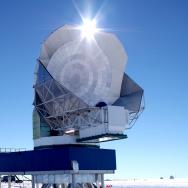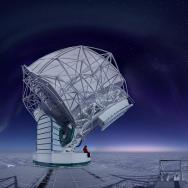A team of scientists have demonstrated how to “weigh” galaxy clusters using light from the earliest moments of the universe—a new method that could help shed light on dark matter, dark energy and other mysteries of the cosmos, such as how the universe formed.
The new method calculates the bending of light around galaxy clusters using the orientation of light from shortly after the Big Bang—data taken by the South Pole Telescope and the Dark Energy Camera.
“Gravitational lensing,” a phenomenon in which light distorts as it’s affected by the gravity of big objects like galaxies, can function as a kind of magnifying glass. It’s helped scientists discover key information about the universe—but it’s always been done by looking for the smearing of light around distant objects like stars.
In a study published in Physical Review Letters, Fermilab and University of Chicago scientist Brad Benson and colleagues use a different method to calculate the masses of distant galaxies: the polarization, or orientation, of the light left over from the moments after the Big Bang.
“Making this estimate is important because most of the mass of galaxy clusters isn’t even visible—it’s dark matter, which does not emit light but interacts through gravity and makes up about 85% of the matter in our universe,” said Benson, an assistant professor in the Department of Astronomy and Astrophysics. “Since photons from the cosmic microwave background have literally traveled across the entire observable universe, this method has the potential to more accurately measure the dark matter mass in the most distant galaxy clusters.”

Clues from the beginning of time
In the infant universe, temperatures were so high that electrons and protons were too hot to form atoms. Everything was a hot, ionized gas, not unlike the surface of the sun.
Over the next 400,000 years, the universe expanded and cooled to about 3,000 degrees Celsius. At these temperatures, electrons and protons combined into hydrogen atoms and released photons in the process. This light, called the cosmic microwave background, or CMB, has been traveling through space ever since—a sort of “time machine” carrying information from the early universe.
At the Amundsen-Scott South Pole Station, support staff and scientists, nicknamed “beakers,” work around the clock to manage the South Pole Telescope. It’s not easy work; it is located at the southernmost place on Earth, where the average temperature is minus 47 degrees Celsius and the sun rises and sets only once a year. But the South Pole Telescope needs this harsh environment to carry out its scientific work.
The camera on the South Pole Telescope measures minuscule fluctuations in the polarization, or orientation, of CMB light across the southern sky on the order of 1 part in 100 million on average, more sensitive than any other experiment to date.
“These minuscule variations can be affected by large objects such as galaxy clusters, which act as lenses that create distinctive distortions in our signal,” Benson said.
The signal Benson and other scientists were searching for was a small-scale ripple around galaxy clusters—an effect called gravitational lensing. You can see a similar effect yourself by looking through the base of a clear wine glass behind which a candle is lit.
“If you look through the bottom of a wine glass base at a flame, you can see a ring of light. That’s like the effect we would see from a strong gravitational lens,” Benson said. “We are seeing a similar effect here, except the distortion is much weaker and the CMB light is spread out over a much larger area on the sky.”

An assist from the Dark Energy Camera
To find the maximum number of clusters, the scientists cross-referenced data from the Dark Energy Survey, a multi-year survey of the sky that captured the locations of more than 17,000 galaxy clusters in the universe.
Then they could put these locations into a computer program that searched for evidence of gravitational lensing by the clusters in the polarization of the CMB. Once evidence was found, they could calculate the masses of the galaxy clusters themselves using their new mathematical estimator.
Though the idea had been proposed, no one had yet demonstrated the method on actual data.
The scientists found the average galaxy cluster mass to be around 100 trillion times the mass of our sun, an estimate that agrees with other methods. A substantial fraction of this mass is in the form of dark matter.
To probe deeper, the scientists plan to perform similar experiments using an upgraded South Pole Telescope camera, SPT-3G, installed in 2017, and a next-generation CMB experiment, CMB-S4, that will offer further improvements in sensitivity and more galaxy clusters to examine.
CMB-S4 will consist of dedicated telescopes equipped with highly sensitive superconducting cameras operating at the South Pole, the Chilean Atacama plateau and possibly northern-hemisphere sites, allowing researchers to constrain the parameters of inflation, dark energy and the number and masses of neutrinos, and even test general relativity on large scales.
Adapted from an article written by Catherine N. Steffel and first published by Fermi National Accelerator Laboratory.
Citation: “Detection of CMB-Cluster Lensing using Polarization Data from SPTpol.” S. Raghunathan et al. (SPTpol and DES Collaboration). Physics Review Letters, Oct. 31, 2019. DOI: 10.1103/PhysRevLett.123.181301








